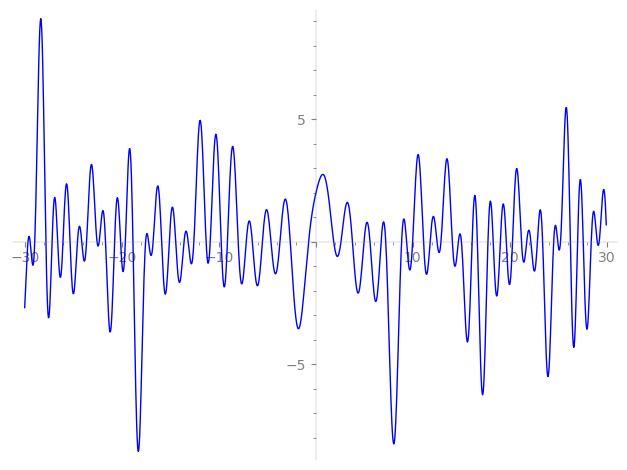| L(s) = 1 | + (0.809 + 0.587i)2-s + (0.309 + 0.951i)4-s + (0.809 − 0.587i)5-s + (−1.07 − 3.31i)7-s + (−0.309 + 0.951i)8-s + 10-s + (2.01 − 2.63i)11-s + (−4.06 − 2.95i)13-s + (1.07 − 3.31i)14-s + (−0.809 + 0.587i)16-s + (−3.05 + 2.21i)17-s + (1.66 − 5.12i)19-s + (0.809 + 0.587i)20-s + (3.17 − 0.951i)22-s + 6.49·23-s + ⋯ |
| L(s) = 1 | + (0.572 + 0.415i)2-s + (0.154 + 0.475i)4-s + (0.361 − 0.262i)5-s + (−0.407 − 1.25i)7-s + (−0.109 + 0.336i)8-s + 0.316·10-s + (0.606 − 0.795i)11-s + (−1.12 − 0.818i)13-s + (0.287 − 0.886i)14-s + (−0.202 + 0.146i)16-s + (−0.740 + 0.537i)17-s + (0.382 − 1.17i)19-s + (0.180 + 0.131i)20-s + (0.677 − 0.202i)22-s + 1.35·23-s + ⋯ |
\[\begin{aligned}\Lambda(s)=\mathstrut & 990 ^{s/2} \, \Gamma_{\C}(s) \, L(s)\cr =\mathstrut & (0.588 + 0.808i)\, \overline{\Lambda}(2-s) \end{aligned}\]
\[\begin{aligned}\Lambda(s)=\mathstrut & 990 ^{s/2} \, \Gamma_{\C}(s+1/2) \, L(s)\cr =\mathstrut & (0.588 + 0.808i)\, \overline{\Lambda}(1-s) \end{aligned}\]
Particular Values
| \(L(1)\) |
\(\approx\) |
\(1.74399 - 0.888114i\) |
| \(L(\frac12)\) |
\(\approx\) |
\(1.74399 - 0.888114i\) |
| \(L(\frac{3}{2})\) |
|
not available |
| \(L(1)\) |
|
not available |
\(L(s) = \displaystyle \prod_{p} F_p(p^{-s})^{-1} \)
| $p$ | $F_p(T)$ |
|---|
| bad | 2 | \( 1 + (-0.809 - 0.587i)T \) |
| 3 | \( 1 \) |
| 5 | \( 1 + (-0.809 + 0.587i)T \) |
| 11 | \( 1 + (-2.01 + 2.63i)T \) |
| good | 7 | \( 1 + (1.07 + 3.31i)T + (-5.66 + 4.11i)T^{2} \) |
| 13 | \( 1 + (4.06 + 2.95i)T + (4.01 + 12.3i)T^{2} \) |
| 17 | \( 1 + (3.05 - 2.21i)T + (5.25 - 16.1i)T^{2} \) |
| 19 | \( 1 + (-1.66 + 5.12i)T + (-15.3 - 11.1i)T^{2} \) |
| 23 | \( 1 - 6.49T + 23T^{2} \) |
| 29 | \( 1 + (0.886 + 2.72i)T + (-23.4 + 17.0i)T^{2} \) |
| 31 | \( 1 + (7.55 + 5.49i)T + (9.57 + 29.4i)T^{2} \) |
| 37 | \( 1 + (-2.73 - 8.42i)T + (-29.9 + 21.7i)T^{2} \) |
| 41 | \( 1 + (-1.79 + 5.51i)T + (-33.1 - 24.0i)T^{2} \) |
| 43 | \( 1 - 3.93T + 43T^{2} \) |
| 47 | \( 1 + (3.70 - 11.4i)T + (-38.0 - 27.6i)T^{2} \) |
| 53 | \( 1 + (-3.41 - 2.48i)T + (16.3 + 50.4i)T^{2} \) |
| 59 | \( 1 + (0.0224 + 0.0690i)T + (-47.7 + 34.6i)T^{2} \) |
| 61 | \( 1 + (-8.87 + 6.44i)T + (18.8 - 58.0i)T^{2} \) |
| 67 | \( 1 - 15.6T + 67T^{2} \) |
| 71 | \( 1 + (3.48 - 2.53i)T + (21.9 - 67.5i)T^{2} \) |
| 73 | \( 1 + (1.85 + 5.70i)T + (-59.0 + 42.9i)T^{2} \) |
| 79 | \( 1 + (-8.67 - 6.29i)T + (24.4 + 75.1i)T^{2} \) |
| 83 | \( 1 + (1.23 - 0.898i)T + (25.6 - 78.9i)T^{2} \) |
| 89 | \( 1 + 3.32T + 89T^{2} \) |
| 97 | \( 1 + (5.44 + 3.95i)T + (29.9 + 92.2i)T^{2} \) |
| show more | |
| show less | |
\(L(s) = \displaystyle\prod_p \ \prod_{j=1}^{2} (1 - \alpha_{j,p}\, p^{-s})^{-1}\)
Imaginary part of the first few zeros on the critical line
−9.745571065195723803491282172262, −9.100511078551917670408231558806, −7.992251539602554943339307095579, −7.16299739624437926547037314955, −6.53213697170820165258419444754, −5.49735168731427314684379218355, −4.61278319988727722088577212973, −3.68692999547767723262629634454, −2.62479162581726710894003238769, −0.73588623193231440831921245305,
1.85647217353799341614999297432, 2.60450242699226702707163333076, 3.78411477983816142990630783076, 4.97514103256098803462797065953, 5.59740216587484532257128778936, 6.74209313546222550578964337886, 7.21671554162040322114963344682, 8.853469428683669596967861654756, 9.367564132957883827530347055624, 9.991262233778940360946038183455

